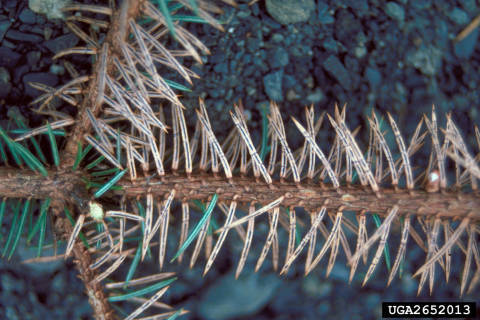

Year-old needles are cast after turning rust colored in the spring. Blue, white, red, black, Engelmann, and Norway spruces are all susceptible to this disease. Anticipate the future needs of the mature tree and consider whether the site has the potential to supply the water required of a specimen 50 to 60 feet tall. Select the planting site carefully, avoiding drought prone sites. Since the fungus readily infects wounded tissue but remains latent in the tree without causing symptoms until the tree is drought stressed, fungicide sprays cannot be effectively timed to prevent this disease. Resin flows out of the cankers and may drip down on lower branches. As with other diseases, ultimate control will be achieved through the use of resistant trees.Sunken dead areas of bark and underlying wood form on the lower branches of the trees girdling small branches in 1 or 2 years and large branches after several years. Although there haven't been any studies in the west, in the central United States two applications of copper fungicides have prevented infection of needles. In some cases, managing Dothistroma needle blight with chemicals has proven feasible. Clean up and dispose of any debris from around the infected trees, including dead needles and fallen limbs. Pruning the lower branches and spacing trees will increase air circulation and can reduce disease severity. The disease is typically worse in the lower crown area of the tree where air circulations is poor. There are some cultural methods that can be used to lessen disease severity. Some seed from Austrian and ponderosa pines have been found that have a useful degree of resistance and have been used for plantings in the Great Plains. As a result, infected needles may produce a lot of sap in response to the infection. One proposed mechanism of resistance involves the plant inhibiting fungal growth by producing fatty acids and resin, or sap, on the surface of needles. There are no species of pine that are completely resistant and resistance will vary greatly among the same species. General instructions for sample collection and shipment can be found at: and directing your browser to the diagnostic laboratory sample submission information. Care should be taken not to expose the bag to excessive heat or cold so that the specimen and pathogen remain alive until the sample is received. Plant tissues should be sealed in a plastic bag and sent to: Utah Plant Diagnostic Lab, Department of Biology, 5305 Old Main Hill, Logan, UT 84322. To do this, collect several branches exhibiting symptoms of infection. If confirmation is desired, the sample may be sent to the diagnostic lab. Local county Extension agents may be able to do this for you. To be sure that Dothistroma needle blight is the problem in your tree, they can be sampled and checked for the the fungus. They then disperse and start infectioning other trees. The spores are exposed as the stromata push through the outer layer of the needle, rupturing it. Stromata will mature and begin producing spores in the spring.

It is typically shorter in the spring and longer in the winter. The interval from infection to when symptoms appear can vary from 4 weeks to 6 months, depending on environmental conditions and hosts. After the first year the disease has occurred, lesions in all stages of development and sporulation can be found throughout the growing season. Second-year needles and older needles can become infected from May to October. First-year needles are typically infected beginning of mid-summer.

Needles will die back to the lesion and break off, leaving a gray or ashy appearance on the needle tips. The red banding symptoms observed on infected needles is the most distinctive symptom of this disease.


 0 kommentar(er)
0 kommentar(er)
